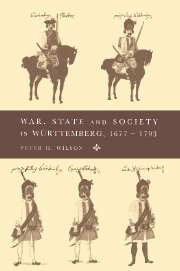Book contents
- Frontmatter
- Contents
- List of illustrations
- List of tables
- Preface
- Note on form
- List of abbreviations
- Introduction
- 1 Princely aims and policy-making
- 2 Strategies and resources
- 3 The German soldier trade
- 4 Regent Friedrich Carl, 1677–1693
- 5 Eberhard Ludwig, 1693–1733
- 6 Carl Alexander, 1733–1737
- 7 The regency, 1737–1744
- 8 Carl Eugen, 1744–1793
- 9 Conclusion
- Appendix
- Bibliography
- Index
- Cambridge Studies in Early Modern History
4 - Regent Friedrich Carl, 1677–1693
Published online by Cambridge University Press: 22 September 2009
- Frontmatter
- Contents
- List of illustrations
- List of tables
- Preface
- Note on form
- List of abbreviations
- Introduction
- 1 Princely aims and policy-making
- 2 Strategies and resources
- 3 The German soldier trade
- 4 Regent Friedrich Carl, 1677–1693
- 5 Eberhard Ludwig, 1693–1733
- 6 Carl Alexander, 1733–1737
- 7 The regency, 1737–1744
- 8 Carl Eugen, 1744–1793
- 9 Conclusion
- Appendix
- Bibliography
- Index
- Cambridge Studies in Early Modern History
Summary
CHARACTER AND AIMS
Friedrich Carl (1652–98) came to power as regent of Württemberg as a result of the unexpected death of his elder brother, Duke Wilhelm Ludwig, after a reign of a mere three years (1674–7). His dual role as ‘Duke Administrator’ and prince of the junior Winnenthal line of the family was to impart special characteristics to his regency. On the one hand, he realised that his nephew Eberhard Ludwig would one day become reigning duke and he would once again he reduced to the relative obscurity of prince of a junior line. He therefore tried to extract maximum advantage for himself and his own sons while his power lasted. On the other hand, owing to the length of his rule – Eberhard Ludwig was scarcely a year old when Friedrich Carl became regent on 27 November 1677 and under Württemberg law could not become duke before his eighteenth birthday in 1694 – he developed attributes of a reigning duke. He therefore interfered in the internal structure of the duchy to a far greater extent than the indecisive regents of the period 1737–44, from whom he differed radically in both youth and character.
Although nominally obliged to share power with the privy council and with Eberhard Ludwig's mother, the pious Magdalene Sibylle (1652–1712), he soon seized the reins of government for himself.
- Type
- Chapter
- Information
- War, State and Society in Württemberg, 1677–1793 , pp. 97 - 124Publisher: Cambridge University PressPrint publication year: 1995



